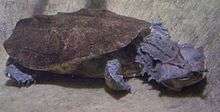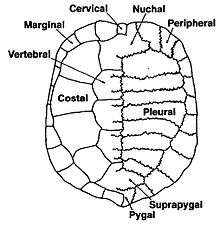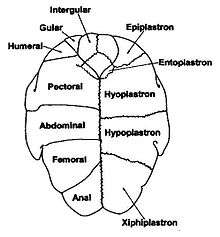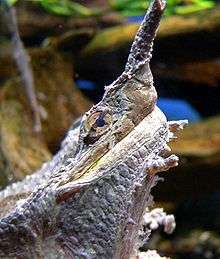Chelidae
The Chelidae are one of three living families of the turtle/tortoise suborder Pleurodira and are commonly called the Austro-South American side-neck turtles.[2] The family is distributed in Australia, New Guinea, parts of Indonesia, and throughout most of South America. It is a large family of turtles with a significant fossil history dating back to the Cretaceous. The family is entirely Gondwanan in origin, with no members found outside Gondwana, either in the present day or as a fossil.[3]
| Chelidae | |
|---|---|
 | |
| Chelus fimbriatus | |
| Scientific classification | |
| Kingdom: | Animalia |
| Phylum: | Chordata |
| Class: | Reptilia |
| Order: | Testudines |
| Suborder: | Pleurodira |
| Family: | Chelidae Gray, 1831[1] |
| Genera | |
|
See text | |
Description
Like all pleurodirous turtles, the chelids withdraw their necks sideways into their shells, differing from cryptodires that fold their necks in the vertical plane. They are all highly aquatic species with webbed feet and the capacity to stay submerged for long periods of time. The snake-necked species (genera Chelus, Chelodina, and Hydromedusa) are largely strike-and-gape hunters or foragers feeding on fish, invertebrates, and gastropods. The short-necked forms are largely herbivorous or molluscivorous, but are also opportunistic, with several species having specialized to eating fruits.
The highly aquatic nature of the group is typified by the presence of cloacal breathing in some species of the genera Elseya and Rheodytes.[4] However, some species, such as the eastern long-neck turtle (Chelodina longicollis) from Australia spend significant periods of time on land and are considered highly terrestrial.
The smaller members of the family include the Macleay River turtle (Emydura macquarii) at around 16 cm,[5] twist-necked turtle (Platemys platycephala) at 18 cm and the western swamp turtle (Pseudemydura umbrina) at 15 cm, whereas the larger species such as the mata mata (Chelus fimbriata) and the white-throated snapping turtle (Elseya albagula) both exceed 45 cm in shell length.[6]
Shell morphology
Members of Chelidae have unique shell morphology. The carapace often has reduced surface exposure of neural bones, or even none at all.[7] This is due to less requirement for enlarged longissimus dorsi muscles in side-necked turtles.[8]
The inside of the carapace is often heavily buttressed. This has sometimes been seen as a defense mechanism, that is it increases the strength of the shell against biting force, however Thomson (2003)[8] demonstrated it is linked to feeding methods and the prevention of internal torsion of the shell. Chelids also lack mesoplastra, which separates them from the Pelomedusidae.

The cervical scute is usually present, though it is absent in some species of Elseya and Myuchelys. Otherwise, the carapace has the usual complement of four costals, five vertebrals and twelve marginals (per side). Internally, the carapace is made of eight pleurals (per side), eleven peripherals (per side), a nuchal at the front and a suprapygal and pygal at the rear of the shell. As noted earlier, neurals, although always present, often exist as subsurface elements above the vertebral column.[7]

The plastron of chelids does not contain any hinges as can appear in some cryptodire turtles. The scute pattern is a unique feature of the Pleurodira and can be used to immediately identify a shell as belonging to this suborder. All cryptodires have 12 plastral scutes, whereas pleurodires have thirteen. The extra scute is called the intergular. The rest of the scutes and the skeletal structure beneath them are the same as all turtles: paired gulars, humerals, pectorals, abdominals, and anals. The skeletal elements consist of a single entoplaston, as well as paired epiplastra, entoplastra, hyoplastra, hypoplastra and xiphiplastra (Pritchard & Trebbau, 1984).[9]
Classification

A number of theories of the relationships within the large chelid family have been posited. Using shared derived characters, an early attempt in the 1970s used strict parsimony to determine the three long-necked genera (Chelodina, Chelus, and Hydromedusa) were each other's closest relatives.[10] This was accepted for some time, but brought into scrutiny,[11] because the major differences between the genera showed they all appeared to have evolved independently of each other, hinging on the fact that although they had long necks, how they used them and their structures were different.
A number of additional data sets were developed that used electrophoresis and nuclear and mtDNA analysis; these all agreed on the independent evolution of the three long-necked clades.[12][13] This was culminated in a reanalysis of the morphological data which demonstrated the convergence of the clades on a sweep of distinctive features needed for their piscivorous diets,[14] Thomson, 2000.[15] The subfamilies within Chelidae show the monophyly of the majority of the South American species and all the Australian species, with the far more ancient Hydromedusa as sister taxon to both these other groups.
The family Chelidae contains about 60 species within around twenty genera:[12]
Suborder Pleurodira
- Family Pelomedusidae
- Family Podocnemididae
- Family Chelidae Gray, 1831[1]
- Subfamily Chelodininae Baur 1893[16]
- Genus †Birlimarr Megirian & Murray 1999[17]
- Genus Chelodina Fitzinger 1826 – Australian snake-necked turtles
- Genus Elseya Gray 1867 – Australian snapping turtles[18]
- Genus Emydura Bonaparte 1836 – Australian short-necked turtles
- Genus Elusor, Cann & Legler, 1994[19] – Mary River turtle
- Genus Flaviemys Le et al., 2013[20] yellow-faced saw-shelled turtles
- Genus Myuchelys Thomson & Georges 2009[21] – Australian saw-shelled turtles
- Genus Rheodytes Legler & Cann, 1980[22] – Fitzroy River turtles
- Subfamily Chelinae Gray, 1825[23]
- Genus Chelus Duméril 1806 – matamata turtles
- Genus Acanthochelys Gray, 1873[24] – South American side-necked swamp turtles
- Genus Mesoclemmys – gibba turtle
- Genus Phrynops – toad-headed turtles
- Genus Platemys Wagner 1830 – twist-necked turtles
- Genus Rhinemys – red-headed side-necked turtle
- Genus †Bonapartemys Lapparent de Broin & de la Fuente, 2001[25]
- Genus †Lomalatachelys Lapparent de Broin & de la Fuente 2001[25]
- Genus †Prochelidella Lapparent de Broin & de la Fuente 2001[25]
- Genus †Palaeophrynops Lapparent de Broin & de la Fuente 2001[25]
- Genus †Parahydraspis Wieland 1923[26]
- Genus †Linderochelys de la Fuente et al., 2007
- Subfamily Hydromedusinae Baur, 1893[27]
- Genus Hydromedusa Wagler 1830 – South American snake-necked turtles
- Genus †Yaminuechelys de la Fuente et al. 2001
- Subfamily Pseudemydurinae Zhang et al., 2017[28]
- Genus Pseudemydura Siebenrock 1901[29] – western swamp tortoise
- Subfamily Chelodininae Baur 1893[16]
| Key to Australasian Chelidae |
|---|
|
1 Forelimbs each with five claws; gular scutes separated by the intergular; intergular scute in broad contact with the anterior margin of the plastron 2 2 Intergular scute not in contact with the pectoral scutes 3 3 Suture between the second and third costal scutes contacting the seventh marginal scute; suture between the third and fourth costal scutes contacting the ninth marginal scute 4 4 Surface of the temporal region covered with distinct regular scales or low tubercles; dorsal surface of the head with a prominent head shield which may be entire or fragmented; cervical scute present or absent 5 5 Precloacal tail length greater than postcloacal length only in adult males; tail round in cross section; cloacal orifice round; tail always shorter than half of carapace length 6 6 Prominent alveolar ridge on the triturating surfaces of the mouth; cervical scute absent (except as a rare variant); no prominent process of the head shield extending down the parietal ridge toward the tympanum Elseya |
Phylogeny
Relationships of the living forms based on Georges et al., 2014.[30]
| Chelidae |
| ||||||||||||||||||||||||||||||||||||||||||||||||||||||||||||||||||||||||||||||||||||
References
- Gray, J. E. (1831). Synopsis Reptilium Or Short Descriptions of the Species of Reptiles. Part 1. Cataphracta, Tortoises, Crocodiles, and Enaliosaurians. London. 85 pp.
- Obst, Fritz Jurgen (1998). Cogger, H. G.; Zweifel, R. G. (eds.). Encyclopedia of Reptiles and Amphibians. San Diego: Academic Press. pp. 111–112. ISBN 0-12-178560-2.
- Georges, A. & Thomson, S. (2006). "Evolution and Zoogeography of Australian freshwater turtles". In: Merrick, J. R.; Archer, M.; Hickey, G. & Lee, M. (eds.) Evolution and Zoogeography of Australasian Vertebrates. Sydney: Australia.
- Gordos, M. A.; Franklin, C. E. & Limpus, C. J. (2004). "Effect of water depth and water velocity upon the surfacing frequency of the bimodally respiring freshwater turtle, Rheodytes leukops". The Journal of Experimental Biology. 207: 3099-3107.
- Cann, J. (2008). Freshwater Turtles: A Wild Australia Guide. Queensland, Australia: Steve Parish Publishing, p. 46.
- Thomson, S.; Georges, A. & Limpus, C. (2006). "A New Species of Freshwater Turtle in the Genus Elseya (Testudines: Chelidae) from Central Coastal Queensland, Australia". Chelonian Conservation and Biology. 5 (1): 74-86.
- Thomson, S. & Georges, A. (1996). "Neural bones in chelid turtles". Chelonian Conservation and Biology 2: 82-86.
- Thomson S. (2003). "Long necks, flat heads and the evolution of piscivory". World Chelonian Trust.
- Pritchard, Peter C. H. & Trebbau, Pedro (1984). The Turtles of Venezuela. Society for the Studies of Amphibians and Reptiles: 403 pp.
- Gaffney, E. S. (1977). "The side-necked turtle family Chelidae: a theory of relationships using shared derived characters". American Museum Novitates. 2620: 1-28.
- Pritchard, P. C. H. (1984). "Piscivory in turtles, and evolution of the long-necked Chelidae". in Ferguson, M. W. (ed) The Structure, Development and Evolution of Reptiles. Zoological Society of London, Symposium. 52: 87-110.
- Georges, A.; Birrell, J.; Saint, K. M.; McCord, W. & Donnellan, S. C. (1998). "A phylogeny for side-necked turtles (Chelonia: Pleurodira) based on mitochondrial and nuclear gene sequence variation". Biological Journal of the Linnean Society. 67: 213-246.
- Seddon, J.; Georges, A.; Baverstock, P. & McCord, W. (1997). "Phylogenetic relationships of chelid turtles (Pleurodira: Chelidae) based on mitochondrial 12S rRNA gene sequence variation". Molecular Phylogenetics and Evolution. 7: 55-61.
- Thomson S. (2003). "Long necks, flat heads and the evolution of piscivory". World Chelonian Trust
- Thomson S. A. (2000). "On the identification of the holotype of Chelodina oblonga (Testudinata: Chelidae) with a discussion of the taxonomic implications". Chelonian Conservation and Biology. 3: 745-749.
- Baur, Georg (1893). "Notes on the classification of the Cryptodira". American Naturalist. 27 :672–674.
- Megirian, D. & Murray, P. (1999). "Chelid turtles (Pleurodira, Chelidae) from the Miocene Camfield Beds, Northern Territory of Australia, with a description of a new genus and species". The Beagle (Records of the Museums and Art Galleries of the Northern Territory). 15: 75–130.
- Gray, J. E. (1867). "Description of a new Australian tortoise (Elseya latisternum)". Annals and Magazine of Natural History. (3) 20: 43-45.
- Cann, J. & Legler, J. M. (1994). "The Mary River Tortoise: a new genus and species of short-necked chelid from Queensland, Australia (Testudines; Pleurodira)". Chelonian Conservation and Biology. 1 (2): 81-96.
- Le, M.; Reid, B. N.; McCord, W. P.; Naro-Maciel, E.; Raxworthy, C. J.; Amato, G. & Georges A. (2013). "Resolving the phylogenetic history of the short-necked turtles, genera Elseya and Myuchelys (Testudines: Chelidae) from Australia and New Guinea". Molecular Phylogenetics and Evolution. 68 (2013) 251–258.
- Thomson, S. & Georges, A. (2009). "Myuchelys gen. nov. — a new genus for Elseya latisternum and related forms of Australian freshwater turtle (Testudines: Pleurodira: Chelidae)". Zootaxa. 2053: 32–42.
- Legler, J. M. & Cann, J. (1980). "A new species of chelid turtle from Queensland, Australia". Contributions to Science, Natural History Museum of Los Angeles County. 324: 1-18.
- Gray, John Edward (1825). "A synopsis of the genera of reptiles and amphibia, with a description of some new species". Annals of Philosophy. (2) 10: 193–217.
- Gray, J. E. (1873). "Observations on chelonians, with descriptions of new genera and species". Annals and Magazine of Natural History. (4) 11: 289-308.
- Broin, F. de & de la Fuente, M. S. (2001). "Oldest world Chelidae (Chelonii, Pleurodira), from the Cretaceous Patagonia, Argentina". Palaeontology 333: 463-470.
- Wieland, G. R. (1923). "A new Parana Pleurodiran". American Journal of Science. 5 (25): 1-15.
- Baur, Georg. (1893). "Notes on the classification and taxonomy of the Testudinata". Proceedings of the American Philosophical Society. 31: 210–225.
- Zhang, X.; Unmack, P. J.; Kuchling, G.; Wang, Y. & Georges, A. (October 2017). "Resolution of the enigmatic phylogenetic relationship of the critically endangered Western Swamp Tortoise Pseudemydura umbrina (Pleurodira: Chelidae) using a complete mitochondrial genome". Molecular Phylogenetics and Evolution. 115: 58-61.
- Seibenrock, F. (1901). "Beschreibung einer neuen schildkrotengattung aus der familie Chelydidae aus Australien: Pseudemydura". Anzeiger der Akademie der Wissenschaften in Wien. 38: 248-251.
- Georges, A.; Zhang, X.; Unmack, P.; Reid, B.; Le, M. & McCord, W. (2014). "Contemporary genetic structure of an endemic freshwater turtle reflects Miocene orogenesis of New Guinea". Biological Journal of the Linnean Society. 2014, 111: 192–208.
External links and further reading
| Wikimedia Commons has media related to Chelidae. |